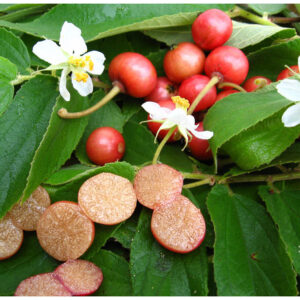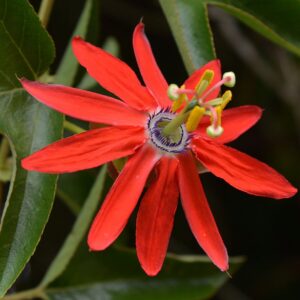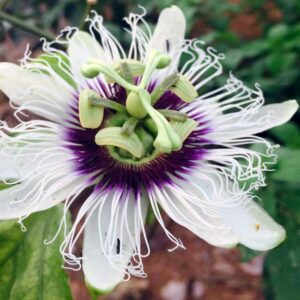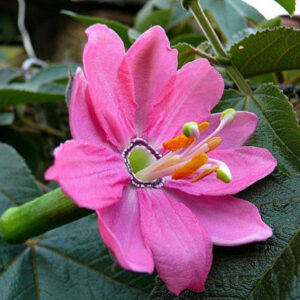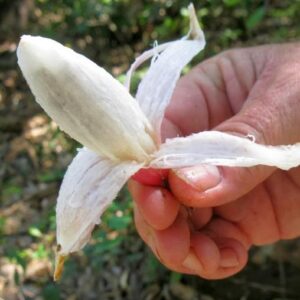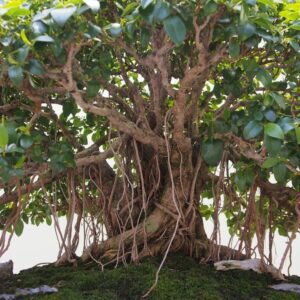$4.33
/ per pack
Choose seeds per pack:
Botanical name: Ziziphus mauritiana
Common name: Indian Jujube, Indian Plum, Chinese Apple, Indian Date, Chinese Date, Dunks
Kingdom: Plantae
Clade: Tracheophytes
Clade: Angiosperms
Clade: Eudicots
Clade: Rosids
Order: Rosales
Family: Rhamnaceae
Genus: Ziziphus
Species: Z. mauritiana
Ziziphus mauritiana, also known as Indian jujube, Indian plum, Chinese date, Chinese apple, and dunks is a tropical fruit tree species belonging to the family Rhamnaceae. It is often confused with the closely related Chinese jujube (Z. jujuba), but whereas Z. jujuba prefers temperate climates, Z. mauritiana is tropical to subtropical.
Ziziphus mauritiana is a spiny, evergreen shrub or small tree up to 15 m high, with trunk 40 cm or more in diameter; spreading crown; stipular spines and many drooping branches. The fruit is of variable shape and size. It can be oval, obovate, oblong or round, and can be 1-2.5 in (2.5-6.25 cm) long, depending on the variety. The flesh is white and crisp. When slightly underipe, this fruit is a bit juicy and has a pleasant aroma. The fruit’s skin is smooth, glossy, thin but tight.
The species is believed to have originated in Indo-Malaysian region of South-East Asia. It is now widely naturalised throughout the Old World tropics from Southern Africa through the Middle East to the Indian Subcontinent and China, Indomalaya, and into Australasia and the Pacific Islands. It can form dense stands and become invasive in some areas, including Fiji and Australia and has become a serious environmental weed in Northern Australia. It is a fast-growing tree with a medium lifespan, that can quickly reach up to 10–40 ft (3 to 12 m) tall.
Ziziphus mauritiana is a medium-sized tree that grows vigorously and has a rapidly developing taproot, a necessary adaptation to drought conditions. The species varies widely in height, from a bushy shrub 1.5 to 2 m tall, to a tree 10 to 12 m tall with a trunk diameter of about 30 cm. Z. mauritiana may be erect or wide-spreading, with gracefully drooping thorny branches, zigzag branchlets, thornless or set with short, sharp straight or hooked spines.
The leaves are alternate, ovate or oblong elliptic with rounded apex, with 3 depressed longitudinal veins at the base. The leaves are about 2.5 to 3.2 cm long and 1.8 to 3.8 cm wide having fine tooth at margin. It is dark-green and glossy on the upper side and pubescent and pale-green to grey-green on the lower side. Depending on the climate, the foliage of the Z. mauritiana may be evergreen or deciduous.
The flowers are tiny, yellow, 5-petalled and are usually in twos and threes in the leaf axils. Flowers are white or greenish white and the fruits are orange to brown, 2–3 cm long, with edible white pulp surrounding a 2-locular pyrene.
This quick growing tree starts producing fruits within three years. The fruit is a soft, juicy, drupe that is 2.5 cm diameter, though in some cultivars the fruit size may reach up to 6.25 cm long and 4.5 cm wide. The form may be oval, obovate, round or oblong; the skin smooth or rough, glossy, thin but tough. The fruit ripen at different times even on a single tree. Fruits are first green, turning yellow as they ripen. The fully mature fruit is entirely red, soft, juicy with wrinkled skin and has a pleasant aroma. The ripe fruit is sweet and sour in taste. Both flesh texture and taste are reminiscent of apples. When under ripe the flesh is white and crispy, acid to subacid to sweet in taste. Fully ripe fruits are less crisp and somewhat mealy; overripe fruits are wrinkled, the flesh buff-coloured, soft, spongy and musky. At first the aroma is apple like and pleasant but it becomes peculiarly musky when overripe. There is a single, hard, oval or oblate, rough central stone which contains 2 elliptic, brown seeds, 1/4 in (6mm) long.
The fruit is eaten raw, pickled or used in beverages. It is quite nutritious and rich in vitamin C. It is second only to guava and much higher than citrus or apples. In India, the ripe fruits are mostly consumed raw, but are sometimes stewed. Slightly underripe fruits are candied by a process of pricking, immersing in a salt solution. Ripe fruits are preserved by sun-drying and a powder is prepared for out-of-season purposes. It contains 20 to 30% sugar, up to 2.5% protein and 12.8?rbohydrates. Fruits are also eaten in other forms, such as dried, candied, pickled, as juice, or as ber butter. In Ethiopia, the fruits are used to stupefy fish.
| Weight | N/A |
|---|
